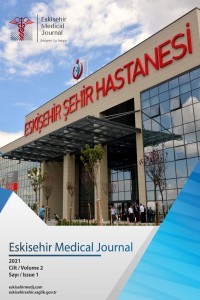Ağır Sigara İçicilerde Yüksek Çözünürlüklü Bilgisayarlı Tomografi Bulguları ve Solunum Fonksiyon Testleri ile Korelasyonu
Toraks YÇBT, solunum fonksiyon testi, sigara içicisi, amfizem
High-resolution computed tomography findings in healthy heavy smokers and correlation with pulmonary function tests
Thorax HRCT, pulmonary function tests, smoker, emphysema,
___
- REFERENCES 1. Sherman CB. Health effects of cigarette smoking. Clinics in chest medicine 1991; 12:643-658.
- 2. Madan R, Matalon S, Vivero M. Spectrum of smoking-related lung diseases. J Thorac Imaging 2016; 31:78-91.
- 3. Benowitz NL, Brunetta PG. Smoking hazards and cessation. 4th ed. Philadelphia Textbook of Respiratory Medicine 2005; 2453-2468.
- 4. Celli BR, MacNee WATS, Agusti AATS, et al. Standards for the diagnosis and treatment of patients with COPD: a summary of the ATS/ERS position paper. Eur Respir J 2004; 23:932-946.
- 5. Wise RA. Chronic Obstructive Pulmonary Disease: Clinical Course and Management 4th ed. New York Fishman's Pulmonary Diseases and Disorders 2008:729-46.
- 6. Halpin DMG , Criner GJ , Papi A, et al. Global initiative for the diagnosis, management, and prevention of chronic obstructive lung disease. The 2020 GOLD Science Committee Report on COVID-19 and Chronic Obstructive Pulmonary Disease. Am J Respir Crit Care Med. 2021; 203:24-36.
- 7. Muller NL. CT diagnosis of emphysema: it may be accurate, but is it relevant? Chest 1993; 103:329-331.
- 8. Lutchmedial SM, Creed WG, Moore AJ, et al. How common is airflow limitation in patients with emphysema on CT scan of the chest? Chest 2015; 148:176-184.
- 9. Remy-Jardin M, Remy J, Boulenguez C, et al. Morphologic effects of cigarette smoking on airways and pulmonary parenchyma in healthy adult volunteers: CT evaluation and correlation with pulmonary function tests. Radiology 1993; 186:107-115.
- 10. Lucidarme O, Coche E, Cluzel P, et al. Expiratory CT scans for chronic airway disease: correlation with pulmonary function test results. AJR Am J Roentgenol 1998; 170:301-307.
- 11. Tavusbay N, Aksel N, Çakan A, et al. Thoracıc Hıgh Resolutıon Computed Tomography Fındıngs of Healthy Smokers. Diseases of Chest 2008; 19: 9-17.
- 12. National Health Interview Survey: Vital and Health Statistics ofthe National Centerfor Health Statistics, Advance Data No. 126. Dept of Health and Human Services, 1986.
- 13. Verschakelen J, Scheinbaum K, Bogaert J, et al. Expiratory CT in cigarette smokers: correlation between areas of decreased lung attenuation, pulmonary function tests and smoking history. Eur Radiol 1998; 8:1391-1399.
- 14. Lynch DA, Al-Qaisi ML. Quantitative CT in COPD. J Thorac Imaging 2013; 28:284.
- 15. Galvin JR, Franks TJ. Smoking-related lung disease. J Thorac Imaging 2009; 24:274-284.
- 16. West J. Distribution of mechanical stress in the lung, a possible factor in localization of pulmonary disease. The Lancet 1971; 297:839-841.
- 17. Kubo K, Eda S, Yamamoto H, et al. Expiratory and inspiratory chest computed tomography and pulmonary function tests in cigarette smokers. Eur Respir J 1999; 13:252-256.
- 18. Johkoh T, Müller NL, Nakamura H. Multidetector spiral high-resolution computed tomography of the lungs: distribution of findings on coronal image reconstructions. J Thorac Imaging 2002; 17:291-305.
- 19. Gurney J. Cross-sectional physiology of the lung. Radiology 1991; 178:1-10.
- 20. Remy-Jardin M, Remy J, Gosselin B, et al. Lung parenchymal changes secondary to cigarette smoking: pathologic-CT correlations. Radiology 1993; 186:643-651.
- 21. Bnà C, Zompatori M, Ormitti F, et al. High-resolution CT (HRCT) of the lung in adults. Defining the limits between normal and pathologic findings. La Radiologia medica 2005; 109:460-471.
- 22. Webb W. High resolution lung computed tomography. Normal anatomic and pathologic findings. Radiol Clin North Am 1991; 29:1051-1063.
- 23. Remy-Jardin M, Edme J-L, Boulenguez C, et al. Longitudinal follow-up study of smoker's lung with thin-section CT in correlation with pulmonary function tests. Radiology 2002; 222:261-270.
- ISSN: 2718-0948
- Yayın Aralığı: Yılda 3 Sayı
- Başlangıç: 2020
- Yayıncı: Eskişehir Şehir Hastanesi
İbrahim Alper YAVUZ, Onur GÖK, Utku GÜRHAN, Fuad ÖKEN
Covid-19 Hastalarında D-dimer ve Eritrosit Dağılım Genişliği Arasındaki İlişkinin Klinik Önemi
Nadir Bir Koroner Arter Çıkış Anomalisi: İkiz Circumflex Arter
Cihan ÖZTÜRK, Melik DEMİR, Burcu ÇAKIR, Kenan YALTA
Koroner no-reflow fenomeninde kontrast ilişkili akut böbrek hasarını öngördüren faktörler
Gökay TAYLAN, Çağlar KAYA, İlhan KILIÇ, Cihan ÖZTÜRK, Kenan YALTA
Is there a covid-19 transmission with percutaneous needle prick? A case report
Murat DUYAN, Serhat GÜNLÜ, Ali SARIDAŞ, Resmiye Nur OKUDAN
Fragmente QRS'nin Varlığı Hemodiyaliz Hastalarında Ventriküler Aritmi ile İlişkili Olabilir
Fatih KARDAŞ, Gökay TAYLAN, Çağlar KAYA, İlhan KURULTAK
Mine TEPETAŞ, Alaettin ÜNSAL, Ahmet AY, Sevda SUNGUR, Didem ARSLANTAŞ, Halime KÜÇÜK
COVID-19 pnömonisinde spontan pnömotoraks ve pnömomediastinum
Atilla PEKÇOLAKLAR, Hasan Oğuz KAPICIBAŞI
Gülsüm Şeyma YALÇIN, Çiğdem ÖZDEMİR, Çiğdem TOKYOL
Siroz Hastalarında Resistinin Hastalık Şiddeti, İnflamasyon ve İnsülin Direnci ile İlişkisi
